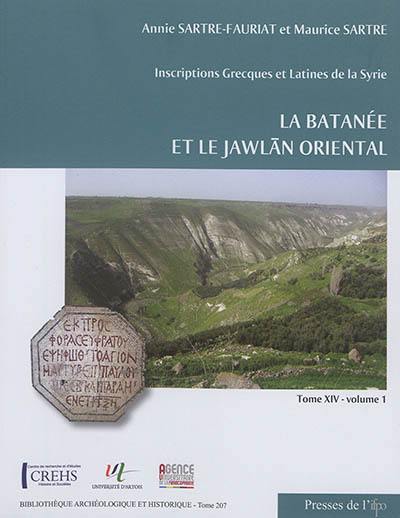
Serie : Inscriptions grecques et latines de la Syrie. Vol 14
Collection(s) : Bibliothèque archéologique et historique
Paru le 22/01/2016 | Broché 707 pages
Professionnels
La Batanée et le Jawlān oriental
Tome XIV - volume 1
Ce volume consacré à la partie occidentale du Hauran regroupe près de huit cents inscriptions, dont plus de quatre cents inédites. La région couverte par la prospection s'étend des limites de la Damascène au nord jusqu'à Der'ā et la frontière jordanienne au sud, et entre la voie de chemin de fer Damas-Der'ā à l'est jusqu'aux limites du gouvernorat de Qunayṭrā à l'ouest. Les inscriptions funéraires forment un ensemble particulièrement abondant, avec de très nombreuses stèles simples, riches d'enseignement sur l'onomastique de la région, mais aussi de belles épitaphes en vers, témoins des goûts et de la culture des élites régionales. Le corpus, essentiellement composé d'inscriptions en grec, comporte aussi l'important dossier des fortifications d'Adraa-Der'a au IIIe siècle au sud et celui de l'administration du domaine impérial de la région nord, localisée à Airè-Ṣanamein. D'autres textes, plus dispersés, permettent de suivre l'évolution géopolitique de la région de l'État-client hérodien jusqu'à la fin de la domination romaine ; elles illustrent les activités de l'administration et de la population, aident à comprendre le cadre de vie de celle-ci (villages, métrokômiai, cités, monuments), tandis que des textes assez nombreux reflètent les croyances, aussi bien dans le cadre du polythéisme antique qu'au sein d'une société en voie de christianisation. Les textes s'échelonnent entre le milieu du Ier siècle de notre ère (règne de Claude, 45-46 ap. J.-C.) et le début du VIIIe siècle (722 ap. J.-C.).
This volume dedicated to the western part of Hauran includes eight hundred inscriptions, among which four hundred are unpublished. The area covered by the exploration extends limits from the boundaries of the Damascus district in the north to Der'ā and the Jordanian border in the south, between the railroad track Der'ā- Damascus in the east to the limits of Qunayṭrā govemorate on the west. Epitaphs form a particularly plentiful group, with numerous simple stelae, rich teaching on the onomastics of the region, but also beautiful epitaphs in verse, witness of the tastes and culture of regional elites. The corpus, essentially consisted of Greek inscriptions, also contains the important file of the fortifications of Adraa-Der'ā during the third century in the south and that of the administration of the imperial domain in the northern region, located in Aire-Ṣanamein. Other texts, more scattered, allow to follow the geopolitical evolution of the region since the herodian State to the end of the Roman domination, they illustrate the activities of the administration and the population, help to understand the living environment of this one (villages, metrokomiai, cities, monuments), whereas a lot of texts reflect the faiths, as well within the framework of the antique polytheism as in a society in the process of Christianization. Texts are spread out between the mid-first century AD (Claudius's reign, 45-46 AD.) and the begining of the eighth century (722 AD.).